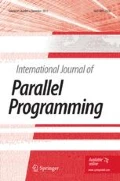Abstract
High performance computers have played key roles in many scientific and engineering advances over the past 40 years, and many more may be expected in the future. However, unless practical parallel systems can be produced in this decade, a performance crisis will arise by 2000 across the spectrum of systems from workstations to supercomputers. There is widespread confusion today about how best to proceed with future parallel systems because so many different approaches have been taken and the performance results have been so spotty. A fundamental flaw in our approach to parallel computing, as a nation, is the poor understanding we have obtained about delivered performance. This paper analyzes the situation and suggests fundamental changes that are necessary to achieve practical parallelism in this decade. A great deal of money is now being spent and more is planned, to advance the field, but money is not so much the problem as shortages of qualified people and a sharp focus for their work. Our national goals for the end of this decade must be the creation of an infrastructure for understanding performance, and its natural consequence, the development of practical parallel systems.
Similar content being viewed by others
References
George Cybenko and David J. Kuck, Revolution or Evolution?,IEEE Spectrum Special Issue: Supercomputers,29(9):39–41 (September 1992).
E. Gallopoulos, E. Houstis, and J. R. Rice, Future Research Directions in Problem Solving Environments for Computational Science,Report of a Workshop on Research Directions in Integrating Numerical Analysis, Symbolic Computing, Computational Geometry, and Artificial Intelligence for Computational Science, NSF, Washington, DC, April 11–12, 1991. CSRD Report Number 1259, Center for Supercomputing Research and Development, University of Illinois, Urbana, Illinois (October 1992).
David Kuck and Ahmed Sameh, A supercomputing Performance Evaluation Plan,Proc. of First Int'l. Conf. on Supercomputing, Athens, Greece, Lecture Notes in Computer Science, T. S. Papatheodorou, E. N. Houstis, C. D. Polychronopoulos (eds.), Springer-Verlag, New York,297:1–17 (1987).
Lyle D. Kipp and David J. Kuck, Newton: Performance Improvement through Comparative Analysis. CSRD Report Number 1286, Center for Supercomputing Research and Development, University of Illinois, Urbana, Illinois (February 1993).
G. Amdahl, The Validity of the Single Processor Approach to Achieving Large Scale Computing Capabilities,AFIPS Proc. SJCC, Vol. 30 (1967).
Utpal Banerjee, Speedup of Ordinary Programs. CSRD Report No. 222, UIUCDCS-R-79-989, Center for Supercomputing Research and Development, University of Illinois, Urbana, Illinois (October 1979).
Committee on Physical, Mathematical, and Engineering Sciences; Federal Coordinating Council for Science, Engineering, and Technology (FCCSET); White House Office of Science and Technology Policy,Grand Challenges 1992; High Performance Computing and Communications. The FY 1992 U.S. Research and Development Program. Supplement to the President's Fiscal Year 1993 Budget, Washington, DC, Chapter 3, pp. 25–39 (1993).
David Kuck, A User's View of High-Performance Scientific and Engineering Software Systems in the Mid-21st Century,Expert Systems for Scientific Computing, E. N. Houstis, J. R. Rice, and R. Vichnevetsky (eds.), North-Holland, Amsterdam, pp. 69–87 (1992).
John R. Rice, Academic Programs in Computational Engineering and Sciences,Computing Research News,3(1):11–12 (March 1991).
Mark D. Guzzi, David A. Padua, Jay Hoeflinger and Duncan H. Lawrie, Cedar Fortran and Other Vector and Parallel Fortran Dialects,The Journal of Supercomputing,3:37–62 (1990).
Bruce Leasure, Walt Rudd, Ross Knippel, Andrew Ingalls, and Cherri Pancake, Parallel Processing Model for High Level Programming Languages, Document No. X3H5/91-0023-G, X3H5 Technical Committee on Parallel Processing Constructs for High Level Programming Languages, American National Standards Committee on Computers and Information Processing (X3), p. 19 (March 1992).
High Performance Fortran Forum,High Performance Fortran Language Specification, David Loveman (ed.), Rice University, Houston, Texas, p. 150 (January 1993).
Dharma P. Agrawal,Advanced Computer Architecture, IEEE Computer Society Press, Washington, DC, p. 383 (1986).
D. Kuck, E. Davidson, D. Lawrie, A. Sameh, C.-Q. Zhu, A. Veidenbaum, J. Konicek, P. Yew, K. Gallivan, W. Jalby, H. Wijshoff, R. Bramley, U. M. Yang, P. Emrath, D. Padua, R. Eigenmann, J. Hoeflinger, G. Jaxon, Z. Li, T. Murphy, J. Andrews, and S. Turner, The Cedar System and an Initial Performance Study. To be presented at theInt'l. Symp. on Computer Architecture, San Diego, California (May 1993).
David L. Parnas, Education for Computing Professionals,Computer,23(1):17–22 (January 1990).
Nathaniel S. Borenstein, Colleges Need to Fix the Bugs in Computer Science Courses,The Chronicle of Higher Education, pp. B3–B4 (July 1992).
Robert Pool, The Third Branch of Science Debuts.Computing in Science. A special section ofScience,256:44–47 (April 1992).
Cybenko, George, Lecture Notes for ECE 371, Topics in Electrical and Computer Engineering, Section GC: Large Scale Scientific and Engineering Computations (unpublished), University of Illinois, Urbana, Illinois (January 1992).
Juris Hartmanis and Herbert Lin, (eds.),Computing the Future: A Broader Agenda for Computer Science and Engineering, Committee to Assess the Scope and Direction of Computer Science and Technology; Computer Science and Telecommunications Board; Commission on Physical Sciences, Mathematics, and Applications; National Research Council, National Academy Press, Washington, DC, p. 272 (1992).
Author information
Authors and Affiliations
Rights and permissions
About this article
Cite this article
Kuck, D.J. What do users of parallel computer systems really need?. Int J Parallel Prog 22, 99–127 (1994). https://doi.org/10.1007/BF02577794
Received:
Issue Date:
DOI: https://doi.org/10.1007/BF02577794




